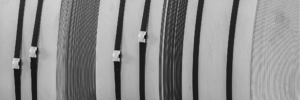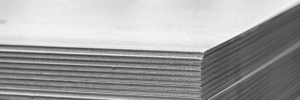| Quality | Standard | Possible coatings |
|---|---|---|
| CR460LA | VDA 239-100 | UC, EG, GI, GA, AS, ZM |
| Testing direction | Yield Point Re (MPa) | Tensil Strength Rm (MPa) | Elongation type 1 A50 (in %) | Type 2 A80 (in %) | Type 3 A50 (in %) |
|---|---|---|---|---|---|
| L | 420 – 520 | 480 – 600 | ≥ 18 | ≥ 17 | ≥ 18 |
| C % | Si % | Mn % | P % | S % | Al % | Ti % | Nb % | Cu % |
|---|---|---|---|---|---|---|---|---|
| ≤ 0,13 | ≤ 0,60 | ≤ 1,70 | ≤ 0,030 | ≤ 0,025 | ≥ 0,015 | ≤ 0,15 | ≤ 0,10 | ≤ 0,20 |
The CR460LA grade, according to VDA 239-100, marks the transition to a very high strength level within the range of cold-rolled micro-alloyed steels. This material was developed to withstand the extreme loads in modern crash structures, where every material saving directly impacts the overall weight. CR460LA is intended for components that require maximum stiffness and strength to protect the passenger compartment. The development and use of this grade are a clear indication of technological progress in automotive material engineering. Like all grades in the VDA 239-100 standard, CR460LA is exclusively optimized and approved for use in vehicle manufacturing, where it provides customized solutions for high-performance components.
Properties
The mechanical properties of CR460LA clearly highlight its position as a high-performance steel. Its minimum yield strength (Rp0.2) is an impressive 460 MPa, while its tensile strength (Rm) must reach at least 480 MPa. These values firmly place the material in the high-strength steel segment.
As expected, the elongation at break is further reduced, with a minimum of 17%. This lower ductility places higher demands on forming. For technicians, this means that component geometry must be planned more carefully, and forming processes must be precisely controlled to avoid cracks.
The chemical composition remains consistent with a very low carbon content and an increased amount of micro-alloying elements. The high concentration of these alloying elements is crucial for achieving high strength through precipitation hardening and grain refinement. Good weldability is maintained, ensuring integration into automated production lines. The surface of the cold-rolled strip is ideally suited for common surface treatments and coatings, such as hot-dip galvanizing.
Applications
The high strength of CR460LA makes it ideally suited for use in components that must ensure high energy absorption and stiffness within a compact space. Typical applications include:
The use of this grade allows for further optimization of vehicle weight, as the required strength values can be achieved with thinner sheets.
Conclusion
With CR460LA according to VDA 239-100, engineers have a material at their disposal that redefines the boundaries of cold forming. It provides the necessary strength for the most demanding crash structures, thereby significantly supporting the further development of passive vehicle safety. Despite its lower elongation, the material remains formable enough for complex profiling, making it a valuable resource for innovative lightweight constructions. For the automotive industry, CR460LA is an indispensable building block for making the next generation of vehicles safer, lighter, and more energy-efficient.
Delivery Forms

Ihr Ansprechpartner
Alex Bachmann
+49 2841/60041 120
+49 173/7545333
Alex.Bachmann@ESB-Group.com






